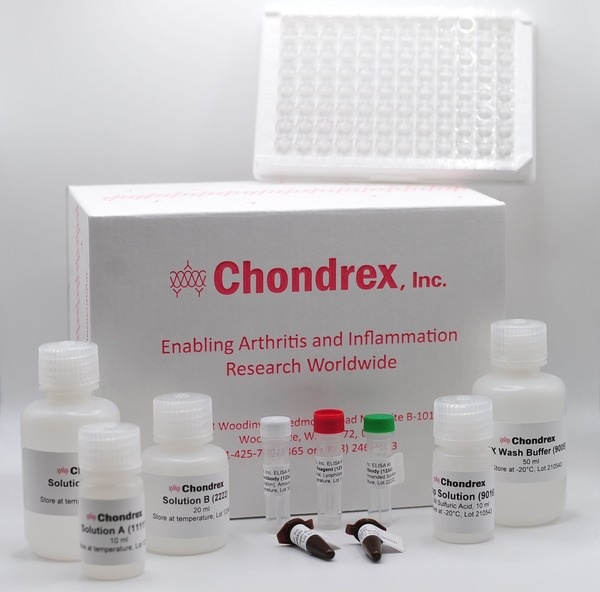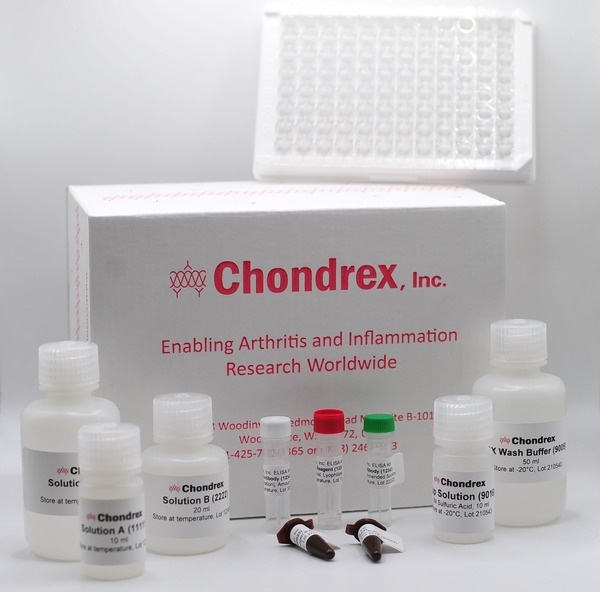Allergic diseases and symptoms arise from an active immune response to normally innocuous antigens, such as pollen, pet dander, or food. Specifically, food allergies and asthma are two common childhood inflammatory diseases that in recent years, have started affecting more individuals.
To analyze the pathogenic role of ovalbumin (OVA), gliadin, house dust mite (HDM) allergen (Der p 10), Acarus siro mite allergens, and peanut Ara allergens in human allergies or animal models of allergies, Chondrex, Inc. provides OVA (Cat # 6032), Gliadin (Cat # 6035), HDM (Der p 10) (Cat # 6031), Acarus siro Antigen (Cat # 6050), and peanut allergen Ara h 1 (Cat # 6045), Ara h 2 (Cat # 6043), Ara h 3 (Cat # 6047), and Ara h 6 (Cat # 6042) Detection ELISA Kits. Furthermore, anti-OVA, anti-Gliadin, anti-HDM, anti-Acarus siro, and anti-Ara allergens monoclonal antibodies and antibody ELISA kits are also available. Please refer to the sections below and their respective product pages for more information.
For more information, please contact Chondrex, Inc. at support@chondrex.com.
Allergic Antigen Detection Assay Kits
| Product | Catalog # | Price (USD) | |
|---|---|---|---|
 |
Acarus siro Antigen Detection Kit | 6050 | 399.00 |
 |
Gliadin Detection Assay Kit | 6035 | 399.00 |
 |
Glutenin Detection Kit | 6052 | 399.00 |
 |
House Dust Mite (Der p 10 and Der f 10) Detection Kit | 6031 | 399.00 |
 |
House Dust Mite (HDM) Der p1 Detection Kit | 6044 | 399.00 |
 |
Ovalbumin (OVA) Detection Assay Kit | 6032 | 399.00 |
 |
Peanut Ara h 1 Detection Assay Kit | 6045 | 399.00 |
 |
Peanut Ara h 2 Detection Assay Kit | 6043 | 399.00 |
 |
Peanut Ara h 3 Detection Assay Kit | 6047 | 399.00 |
 |
Peanut Ara h 6 Detection Assay Kit | 6042 | 399.00 |
Gliadin
A food allergy is an immune response to foods or food ingredients that most other people can tolerate without issue. Wheat is the most widely consumed food grain in the world. One of wheat proteins, gliadins are classified by their differing primary structures into alpha-, beta-, gamma-, and omega- gliadins which range in molecular weight from 28 - 55 kDa and play a critical role in activating both the innate and adaptive immune response, which results in the immune-mediated damage of the intestine such as high intestinal permeability and lamina propria inflammatory cell infiltration. Therefore, gliadins can trigger Celiac disease (CD) which is an autoimmune disorder in genetically susceptible individuals. Mouse CD models have widely been used to study the pathogenesis of gliadin and its immune responses (1-4). For more details about the gliadin-induced CD mouse models, please refer to Chondrex, Inc.'s Mouse Anti-Gliadin Antibody Assay Kits page.
HDM
Asthma is a chronic inflammatory disease that affects 300 million people of all ages worldwide (5. It is caused by exposure to allergens such as dust mites, pet dander, pollen, or mold, and characterized by reversible airway obstruction and bronchospasm. House dust mite (HDM) allergens are the most important indoor allergens in humans (6). Approximately 10% of asthma patients sensitized to HDM demonstrate IgE antibodies to Der p10, a 32 kDa protein of group 10 allergen (tropomyosins) from dust mite, Dermatophagoides pteronyssius. Tropomyosins of a similar structure are found in invertebrates such as crustaceans (shrimp, lobster, crawfish, and crab), arachnids (house dust mites), insects (cockroaches), and mollusks. Tropomyosin is a heat-stable protein and sensitization may lead to severe reactions to the allergenic source. Therefore, the Der p10 antigen may play a role in the cross-induction of allergic reactions to many allergens (7). For more details about mouse HDM-induced asthma models, please refer to Chondrex, Inc.'s HDM Induced Asthma Model page.
Other Mites
Asthma and other respiratory diseases caused by sensitization to mites are global health problems. Because mites are found in both temperate and subtropical climates, a large proportion of the world's population is exposed. In addition to the well-documented mites, Dermatophagoides pteronyssinus and Dermatophagoides farinae, species such as Acarus siro and Lepidoglyphus destructor are emerging as significant contributors to allergies also (8). These storage mites are commonly found in stored foods such as grains, flour, and hay and they can thrive in warm, humid conditions with an optimum relative humidity of 80% and temperatures between 25 and 30°C (9). They are known to cause symptoms such as bronchial asthma, allergic rhinitis, and conjunctivitis, particularly in rural work environments
OVA
Chicken egg allergy is the second most common food allergy (the first being bovine milk allergy) and is observed in 0.5 to 2.5% of young children. Egg allergy is an immunological reaction induced by egg proteins and is defined as an allergen-specific IgE antibody-mediated allergic response, also known as a type I food allergy. Among egg proteins, ovalbumin (OVA) is one of the identified allergenic proteins (10). OVA, a 42.7 kDa glycoprotein, consists of three different subclasses, A1, A2 and A3, which contain two, one and no phosphate groups per molecule, respectively. OVA is a widely used antigen for inducing allergic reactions in experimental animals (7,11,12). For more details about mouse OVA-induced allergy models, please refer to Chondrex, Inc.'s OVA Allergy Model page.
Peanut Allergens
Immediate hypersensitivity reactions to peanuts, an IgE-mediated food allergy, have been a major public health concern for many years, particularly in westernized countries where peanut allergies can persist into adulthood. For allergic patients, avoidance currently remains the only viable option (13). Eleven potentially important peanut allergens have been identified. Ara h1, Ara h2, Ara h3, and Ara h6 have been designated the major peanut allergens. Ara h2 and Ara h6, two highly related 2S albumins belonging to seed storage proteins, especially contribute to the development of allergic reactions (14). Ara h2 contains ten independent IgE-binding linear epitopes. Two isoforms, Ara h 2.01 and Ara h 2.02, were identified respectively as a 17 and 19-kDa doublet on SDS-PAGE. The larger isoform containing twelve extra amino acids including a duplication of a strong IgE-binding sequence, DPYSPS, can bind more IgE antibodies (15, 16). Ara h6 can be a useful analytical target for validating peanut-free foods. This application is not limited to only food testing either, as interestingly, serum Ara h6 levels correlate with peanut allergy tolerance in patients and can be a useful marker of tolerance levels in therapeutic studies (17). For more details about mouse peanut extract-induced allergic models, please refer to Chondrex, Inc.'s Mouse Anti-Crude Peanuts Extract Antibody ELISA Kits page.
References
- P. Gourbeyre, S. Denery-Papini, C. Larré, J.-C. Gaudin, C. Brossard, M. Bodinier, Wheat gliadins modified by deamidation are more efficient than native gliadins in inducing a Th2 response in Balb/c mice experimentally sensitized to wheat allergens. Mol. Nutr. Food Res. 56, 336-344 (2012).
- E. Ferrari, R. Monzani, V. Saverio, M. Gagliardi, E. Pańczyszyn, V. Raia, V. R. Villella, G. Bona, M. Pane, A. Amoruso, M. Corazzari, Probiotics Supplements Reduce ER Stress and Gut Inflammation Associated with Gliadin Intake in a Mouse Model of Gluten Sensitivity. Nutrients. 13 (2021), doi:10.3390/nu13041221.
- M. Bodinier, M. Leroy, S. Ah-Leung, F. Blanc, O. Tranquet, S. Denery-Papini, J.-M. Wal, K. Adel-Patient, Sensitization and elicitation of an allergic reaction to wheat gliadins in mice. J. Agric. Food Chem. 57, 1219-1225 (2009).
- C. Taube, X. Wei, C. H. Swasey, A. Joetham, S. Zarini, T. Lively, K. Takeda, J. Loader, N. Miyahara, T. Kodama, L. D. Shultz, D. D. Donaldson, E. H. Hamelmann, A. Dakhama, E. W. Gelfand, Mast cells, Fc epsilon RI, and IL-13 are required for development of airway hyperresponsiveness after aerosolized allergen exposure in the absence of adjuvant. J. Immunol. 172, 6398-6406 (2004).
- A. Oshiba, E. Hamelmann, K. Takeda, K. L. Bradley, J. E. Loader, G. L. Larsen, E. W. Gelfand, Passive transfer of immediate hypersensitivity and airway hyperresponsiveness by allergen-specific immunoglobulin (Ig) E and IgG1 in mice. J. Clin. Invest. 97, 1398-1408 (1996).
- T. Buday, J. Plevkova, House Dust Mite Allergy Models - Reliability for Research of Airway Defensive Mechanisms. OJMIP 04, 27-35 (2014).
- R. H. Shafique, M. Inam, M. Ismail, F. R. Chaudhary, Group 10 allergens (tropomyosins) from house-dust mites may cause covariation of sensitization to allergens from other invertebrates. Allergy Rhinol (Providence) 3, e74-90 (2012).
- C. Luczynska, P. Griffin, R. Davies, M. Topping, Prevalence of specific IgE to storage mites (A. siro, L. destructor and T. longior) in an urban population and crossreactivity with the house dust mite (D. pteronyssinus). Clin Exp Allergy 20(4), 403-6 (1990).
- I. Sánchez-Ramos, F. Alvarez-Alfageme, P. Castañera, Effects of relative humidity on development, fecundity and survival of three storage mites. Exp Appl Acarol 41(1-2), 87-100 (2007).
- J. Caubet, J. Wang, Current Understanding of Egg Allergy. Pediatr Clin North Am 58, 427-43, xi (2011).
- T. Morokata, J. Ishikawa, T. Yamada, Differential susceptibility of C57BL/6 and DBA/2 mice to ovalbumin-induced pulmonary eosinophilia regulated by Th1/Th2-type cytokines. Immunol. Lett. 70, 127-134 (1999)
- E. Hamelmann, K. Tadeda, A. Oshiba, E. W. Gelfand, Role of IgE in the development of allergic airway inflammation and airway hyperresponsiveness--a murine model. Allergy. 54, 297-305 (1999).
- A. W. Burks, Peanut allergy. Lancet. 371, 1538-1546 (2008).
- Y. Zhuang, S. C. Dreskin, Redefining the major peanut allergens. Immunol. Res. 55, 125-134 (2013).
- X. Chen, Q. Wang, R. El-Mezayen, Y. Zhuang, S. C. Dreskin, Ara h 2 and Ara h 6 Have Similar Allergenic Activity and Are Substantially Redundant. Int. Arch. Allergy Immunol. 160, 251-258 (2013).
- M. Suhr, D. Wicklein, U. Lepp, W.-M. Becker, Isolation and characterization of natural Ara h 6: evidence for a further peanut allergen with putative clinical relevance based on resistance to pepsin digestion and heat. Mol. Nutr. Food Res. 48, 390-399 (2004).
- H. Bernard, P. J. Turner, S. Ah-Leung, M. Ruiz-Garcia, E. N. Clare Mills, K. Adel-Patient, Circulating Ara h 6 as a marker of peanut protein absorption in tolerant and allergic humans following ingestion of peanut-containing foods. Clin. Exp. Allergy. 50, 1093-1102 (2020).